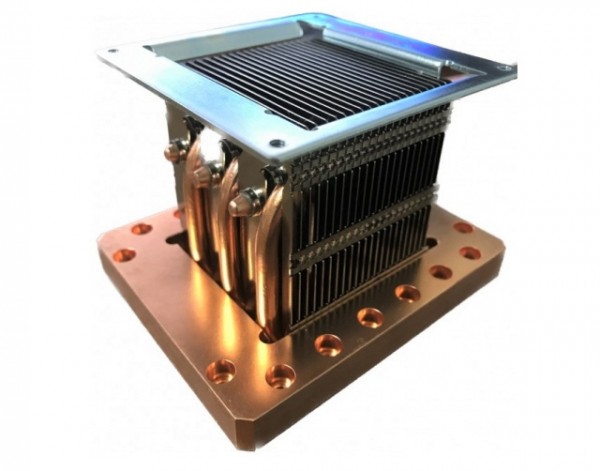68. Heat Pipe With Zipper Fin Heat Sink
페이지 정보
작성자 최고관리자 작성일 23-07-05 22:59본문
[CU Mold, Heat Pipe, AL Zipper Fin and Fan Duct]
What is a Heat Pipe?
A heat pipe is a heat transferring device. A sealed metal tube containing liquid is encased in insulation with one end exposed to the atmosphere and the other submerged in a fluid so its interior can vaporize without boiling away.
This vapour condenses again on the tube walls close to where it enters as it travels through the tube.
The process cools by extracting sensible heat from higher temperature regions near one end of the pipe to areas near the other end at a lower temperature.
By removing latent energy as slugs of liquid moving around inside have tugged on their surrounding gases molecules tugging rather than just being reprocessed.
So you can say that if materials are hot, they radiate energy out, which might be felt as hot.
In a closed tube capillary, the liquid would boil away and fail.
Still, by adding an opening to allow some of it to return to its calm rest position in contact with the metal, it has time to remove the latent energy from gas molecules tugging on them before they can return to their normal state where they no longer pull on other molecules.
Heat pipes keep a moving liquid cool by allowing it to evaporate into a gas and condense back into a liquid on the other end, where there is already a lower temperature.
How Does Heat Pipe Work?
Heat pipes are simply metal lengths containing a liquid that heats up to evaporate into gas, then condenses back to liquid at the other end. The cool thing about them is they use this process of evaporation and condensation to transfer heat.
The hot end is connected to a component that emits waste heat, while the cold end of the pipe is cooled by contact with air or a liquid.
The working fluid in the pipe absorbs this waste heat and carries it away, vaporizing as it does so.
The vaporization process creates a pressure differential between the two ends of the pipe, which causes the working fluid to flow along the length of the tube.
The vaporized working fluid then condenses at the cold end, releasing its latent energy and causing the cycle to repeat.
Applications of Heat Pipe Heat Sink
1. Computers – Heat pipe heat sinks are commonly used to dissipate the waste heat generated by the CPU and graphics card.
2. Electronics – They are used in a wide range of electronic devices, including smartphones, tablets, and laptops.
3. Vehicles – Heat pipe heat sinks are used in various vehicles, including cars, trains, and planes.
4. Buildings – They are used in buildings for heating and cooling applications.
5. Industrial Processes – Heat pipe heat sinks are used in various industrial processes to dissipate waste heat.
6. Solar Energy Systems – They are used to lower the solar panel temperature in solar energy systems.
7. Telecommunications – Heat pipe heat sinks are used in telecommunications devices, such as modems, routers, and set-top boxes.
8. Refrigerators – They are also used in some types of refrigeration units that require only a small amount of cooling.
9. Marine – Heat pipe heat sinks are used in marine applications, especially for engines and generators.
10. Other Applications – Some other types of applications that require the removal or transfer of large amounts of waste heat with minimal maintenance or fan noise.
What is a Heat Pipe?
A heat pipe is a heat transferring device. A sealed metal tube containing liquid is encased in insulation with one end exposed to the atmosphere and the other submerged in a fluid so its interior can vaporize without boiling away.
This vapour condenses again on the tube walls close to where it enters as it travels through the tube.
The process cools by extracting sensible heat from higher temperature regions near one end of the pipe to areas near the other end at a lower temperature.
By removing latent energy as slugs of liquid moving around inside have tugged on their surrounding gases molecules tugging rather than just being reprocessed.
So you can say that if materials are hot, they radiate energy out, which might be felt as hot.
In a closed tube capillary, the liquid would boil away and fail.
Still, by adding an opening to allow some of it to return to its calm rest position in contact with the metal, it has time to remove the latent energy from gas molecules tugging on them before they can return to their normal state where they no longer pull on other molecules.
Heat pipes keep a moving liquid cool by allowing it to evaporate into a gas and condense back into a liquid on the other end, where there is already a lower temperature.
How Does Heat Pipe Work?
Heat pipes are simply metal lengths containing a liquid that heats up to evaporate into gas, then condenses back to liquid at the other end. The cool thing about them is they use this process of evaporation and condensation to transfer heat.
The hot end is connected to a component that emits waste heat, while the cold end of the pipe is cooled by contact with air or a liquid.
The working fluid in the pipe absorbs this waste heat and carries it away, vaporizing as it does so.
The vaporization process creates a pressure differential between the two ends of the pipe, which causes the working fluid to flow along the length of the tube.
The vaporized working fluid then condenses at the cold end, releasing its latent energy and causing the cycle to repeat.
Applications of Heat Pipe Heat Sink
1. Computers – Heat pipe heat sinks are commonly used to dissipate the waste heat generated by the CPU and graphics card.
2. Electronics – They are used in a wide range of electronic devices, including smartphones, tablets, and laptops.
3. Vehicles – Heat pipe heat sinks are used in various vehicles, including cars, trains, and planes.
4. Buildings – They are used in buildings for heating and cooling applications.
5. Industrial Processes – Heat pipe heat sinks are used in various industrial processes to dissipate waste heat.
6. Solar Energy Systems – They are used to lower the solar panel temperature in solar energy systems.
7. Telecommunications – Heat pipe heat sinks are used in telecommunications devices, such as modems, routers, and set-top boxes.
8. Refrigerators – They are also used in some types of refrigeration units that require only a small amount of cooling.
9. Marine – Heat pipe heat sinks are used in marine applications, especially for engines and generators.
10. Other Applications – Some other types of applications that require the removal or transfer of large amounts of waste heat with minimal maintenance or fan noise.




